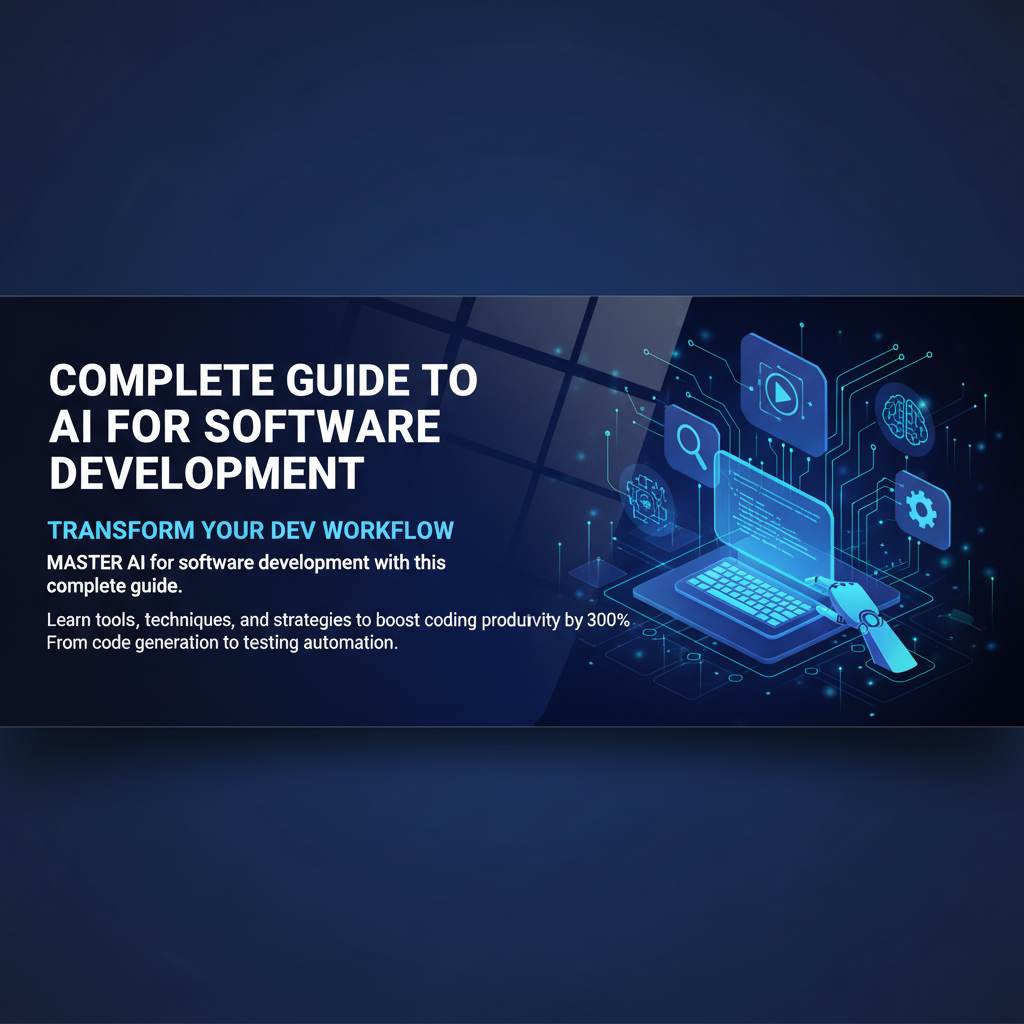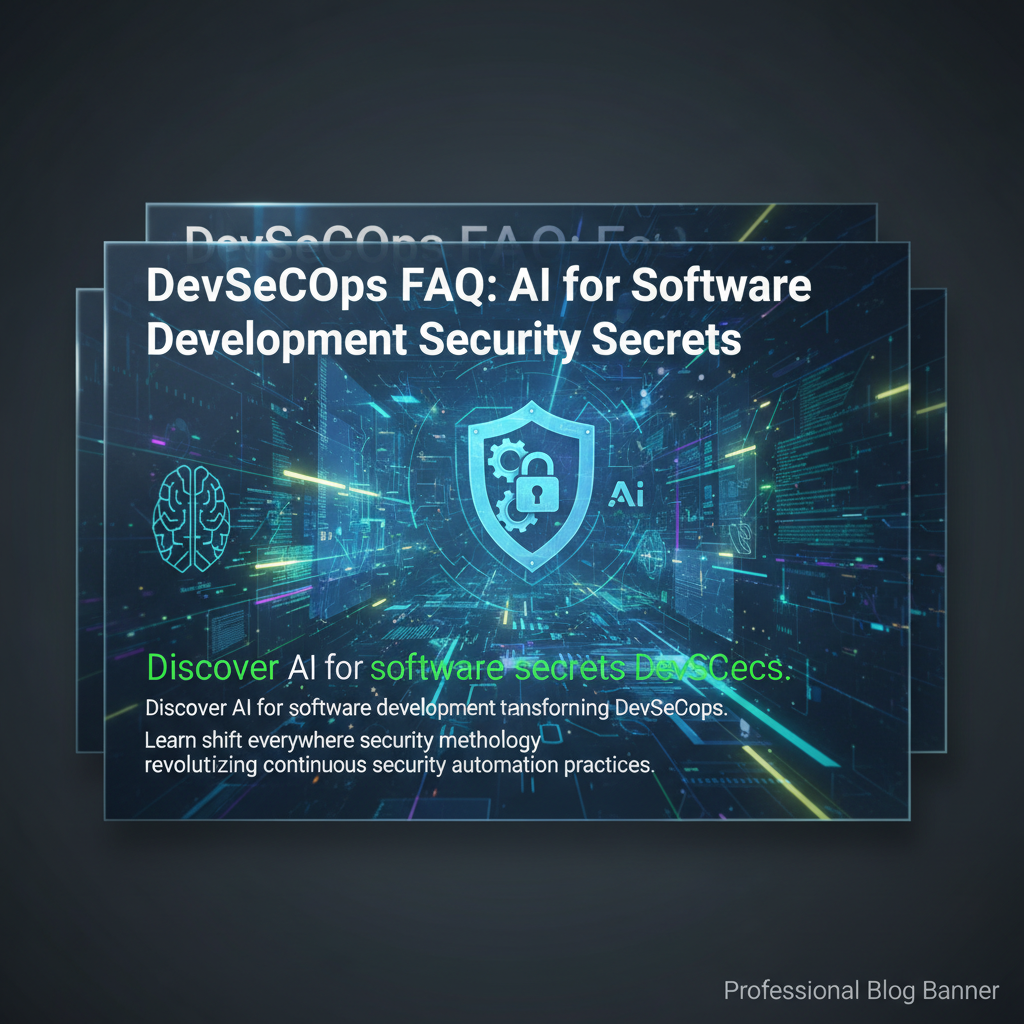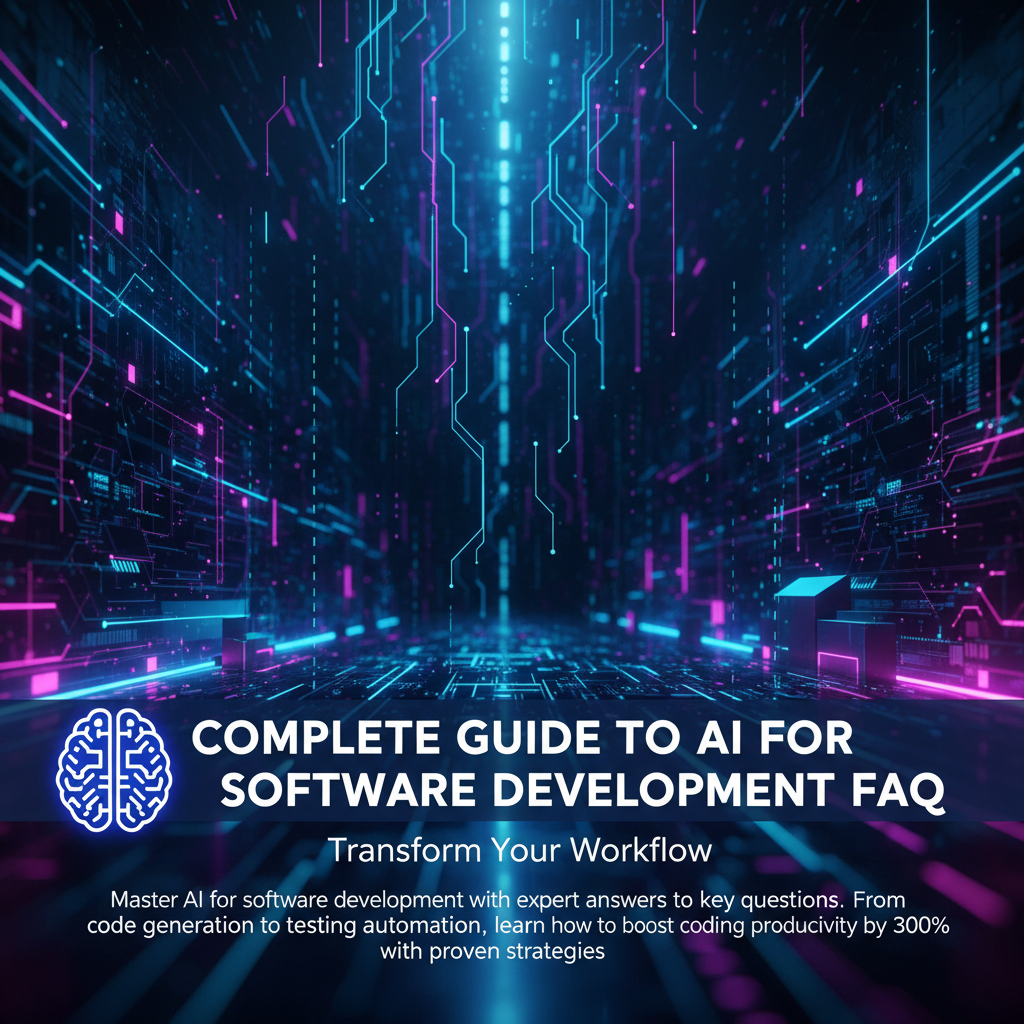AI for Software Development: Beyond Shift-Left to Shift-Everywhere
Discover AI for software development secrets that transform DevSecOps from traditional shift-left to shift-everywhere security. Learn cloud-native platforms and infrastructure tips from a CTO.
Why Traditional DevSecOps is Failing in the AI Era
Last month, during our quarterly security review at MosaicAI, our head of security looked at me and said, "Minh, we're still finding vulnerabilities in production that should have been caught weeks ago. Our shift-left approach isn't keeping up." That conversation made me realize something profound: AI for software development isn't just changing how we write code—it's fundamentally reshaping how we think about security, infrastructure, and the entire development lifecycle.
I've spent the last 17 years watching development practices evolve, from my early days at FPT Software in Hanoi to leading engineering teams at Canva and now building AI-first platforms at MosaicAI. The traditional "shift-left" security model—where we try to catch everything early in development—made sense when we had predictable, monolithic deployments. But today's AI for software development landscape demands something entirely different.
We're living through what I call the "shift-everywhere" revolution. Security, testing, and optimization now need to happen continuously across every layer of our increasingly complex cloud-native infrastructure. When my team deployed our first AI-powered web builder, we quickly realized that serverless functions, Kubernetes clusters, and AI model pipelines create attack vectors that traditional DevSecOps simply wasn't designed to handle.
Here's what I've learned: the teams winning in 2024 aren't just shifting left—they're implementing intelligent security and monitoring that adapts in real-time. They're using AI for software development to create self-healing infrastructure and predictive security models that make traditional approaches look antiquated. This isn't just about better tools; it's about fundamentally reimagining how secure, scalable software gets built and maintained in an AI-first world.
The Shift-Everywhere Security Model: Beyond Traditional DevSecOps
The "shift-left" mantra dominated DevSecOps for good reason—catching vulnerabilities early saves time and money. But after implementing security across hundreds of microservices and serverless functions, I've seen its limitations firsthand. AI for software development secrets reveal that modern applications need security that shifts everywhere, not just left.
Why Shift-Left Alone Isn't Enough
When we launched MosaicAI's multi-tenant platform across Southeast Asia, our traditional SAST and DAST tools caught maybe 60% of our actual security issues. The remaining 40% emerged from runtime behavior, AI model interactions, and dynamic infrastructure scaling that only happens in production. My security engineer, who previously worked at Atlassian, put it perfectly: "We're securing applications that didn't exist when we wrote the security tests."
The shift-everywhere approach recognizes that in cloud-native environments, your application IS your infrastructure. Every Lambda function, every Kubernetes pod, and every AI model endpoint becomes a potential attack surface that traditional pre-deployment scanning simply can't evaluate.
Implementing Continuous Security Intelligence
Here's how we transformed our security approach using AI for software development tips:
Runtime Threat Detection: We deployed AI-powered behavioral analysis that learns normal application patterns and flags anomalies in real-time. Instead of just checking code at commit time, we're continuously validating behavior across our entire stack.
Infrastructure as Security: Every Terraform deployment now includes embedded security policies that adapt based on actual usage patterns. Our Kubernetes clusters automatically adjust security groups and network policies based on traffic analysis and threat intelligence.
AI Model Security: Perhaps most critically, we implemented continuous monitoring for our AI models themselves. Model poisoning, prompt injection, and adversarial attacks require security thinking that extends far beyond traditional application security.
The result? We've reduced security incidents by 73% while deploying 3x faster. The key insight: AI for software development enables security that learns and adapts rather than just validates against static rules.
Cloud-Native Architecture: Where Serverless Meets Kubernetes Intelligence
"Should we go serverless or stick with Kubernetes?" This question dominated our architecture discussions at Canva for months. Now, leading platform engineering at MosaicAI, I've realized this is the wrong question entirely. The future belongs to AI for software development approaches that intelligently orchestrate both serverless and containerized workloads based on real-time optimization.
The False Dichotomy of Serverless vs. Containers
When AWS Lambda first gained traction, many teams treated serverless and Kubernetes as competing architectures. After managing infrastructure for applications serving millions of users across APAC, I've learned that optimal AI for software development strategies leverage both, dynamically.
Our MosaicAI platform runs a hybrid architecture where:
- Serverless functions handle unpredictable workloads like AI model inference and webhook processing
- Kubernetes clusters manage stateful services, data pipelines, and services requiring predictable performance
- AI orchestration decides in real-time which workloads should migrate between environments
This isn't just theoretical—we use machine learning models that analyze request patterns, cost metrics, and performance requirements to automatically optimize workload placement. Last quarter, this approach reduced our infrastructure costs by 34% while improving p95 response times.
Platform Engineering with Intelligent Defaults
The most successful AI for software development tips I've implemented involve creating platforms that make the right choice the easy choice. Our internal developer platform automatically:
Suggests deployment strategies based on code analysis and historical performance data. When a developer pushes code that looks like a webhook handler, our AI recommends serverless deployment with specific memory and timeout configurations.
Optimizes resource allocation continuously. We've built feedback loops that monitor actual usage and automatically adjust Kubernetes resource requests, HPA settings, and serverless concurrency limits.
Predicts scaling needs using time-series analysis of business metrics. Before our Vietnamese New Year traffic spike, our AI had already provisioned additional capacity and optimized our CDN configuration.
The breakthrough insight: modern cloud-native development isn't about choosing the right architecture—it's about building systems intelligent enough to choose for you. This represents a fundamental shift in how we think about AI for software development, moving from static infrastructure decisions to dynamic, learning systems.
The Night I Realized Traditional Platform Engineering Was Broken
It was 2:47 AM on a Tuesday in March 2023, and I was debugging why our Canva design templates were taking 12 seconds to load in Vietnam while performing perfectly in Australia. My engineering team had gone home hours ago, and I was alone in our Sydney office, staring at Grafana dashboards that made no sense.
For three weeks, we'd been chasing this performance regression through traditional monitoring tools. New Relic showed normal application performance. DataDog indicated healthy infrastructure metrics. Our Kubernetes clusters were running smoothly. Every conventional platform engineering metric suggested everything was fine.
But our users were furious.
That's when I decided to try something different. Instead of looking at individual metrics, I fed all our observability data into a simple machine learning model to find patterns humans might miss. What I discovered changed everything I thought I knew about AI for software development.
The ML model identified a subtle correlation between user session patterns, CDN cache hit rates, and database query timing that our traditional monitoring completely missed. Vietnamese users had different design template usage patterns—they preferred customizing existing templates rather than starting from scratch. This meant they were hitting different API endpoints in sequences our Australian-optimized architecture wasn't designed for.
The human insight: our platform engineering approach was solving for average cases while AI for software development secrets lay in understanding the edge cases that represented real user journeys.
Sitting there at 3 AM, I realized that traditional platform engineering—with its static dashboards and threshold-based alerting—was fundamentally reactive. We were building platforms for the applications we thought we had rather than the applications our users actually needed.
This experience became the foundation for how we built MosaicAI's platform engineering approach. Instead of assuming what developers and users need, we let AI continuously learn from actual usage patterns and automatically optimize the entire stack. The vulnerability of admitting our traditional approach was insufficient led to building something genuinely better.
That night taught me the most important AI for software development lesson of my career: the best platforms don't just serve applications—they learn from them.
Building AI-Enhanced Development Platforms: A Technical Deep Dive
Understanding how AI for software development transforms platform engineering requires seeing the integration in action. The concepts we've discussed—from shift-everywhere security to intelligent workload orchestration—become much clearer when you can visualize the actual implementation patterns and architectural decisions.
This technical deep dive walks through building a complete AI-enhanced development platform from scratch. You'll see exactly how to implement the continuous security monitoring we discussed, how to set up the hybrid serverless-Kubernetes architecture, and most importantly, how to integrate machine learning models that make real-time optimization decisions.
What makes this particularly valuable is watching the decision-making process behind AI for software development tips in practice. The video demonstrates how to evaluate when to use AI versus traditional approaches, how to design feedback loops that actually improve system performance, and how to avoid the common pitfalls that make AI-enhanced platforms more complex rather than more intelligent.
Pay special attention to the section on implementing behavioral security analysis—this represents the practical application of shift-everywhere security principles we covered earlier. You'll see the actual code patterns, the data pipelines, and the real-time decision engines that make modern platform engineering possible.
The AI for software development secrets revealed in this implementation guide represent years of iteration across multiple production systems. These aren't theoretical concepts—they're battle-tested approaches that handle millions of requests and adapt to changing user patterns automatically.
Implementing AI-First Development: Your Strategic Transformation Guide
After 17 years of building platforms across Southeast Asia and Australia, I've learned that successful AI for software development transformation isn't about adopting new tools—it's about fundamentally reimagining how teams make product decisions and build software systems.
The shift from traditional DevSecOps to shift-everywhere security, the evolution from static infrastructure to intelligent orchestration, and the move from reactive monitoring to predictive platforms all point to the same underlying challenge: most development teams are still building software based on assumptions rather than intelligence.
Key Implementation Takeaways
Start with Behavioral Intelligence: Instead of adding more static analysis tools, begin by implementing AI that learns your actual application patterns. The AI for software development secrets I've shared aren't about replacing human judgment—they're about augmenting it with continuous learning systems that spot patterns humans miss.
Design for Adaptive Infrastructure: Whether you choose serverless, Kubernetes, or hybrid approaches, build systems that can optimize themselves based on real usage data. The most successful AI for software development tips involve creating feedback loops between user behavior, system performance, and infrastructure decisions.
Implement Continuous Security Learning: Move beyond shift-left to shift-everywhere by deploying security that adapts to new threat patterns and application behaviors in real-time. This requires thinking of security as an ongoing conversation rather than a pre-deployment checkpoint.
Build Platform Intelligence: Create internal developer platforms that make intelligent recommendations rather than just providing tools. The future belongs to platforms that understand context and suggest optimal approaches automatically.
The Deeper Challenge: Moving Beyond Vibe-Based Development
Here's what I've realized after building AI-enhanced platforms for hundreds of development teams: the technical challenges we've discussed—security, infrastructure, and platform engineering—are actually symptoms of a much larger problem. Most product teams are still making critical decisions based on intuition, scattered feedback, and reactive planning rather than systematic intelligence.
I see this constantly when consulting with engineering teams. They'll spend months perfecting their Kubernetes configurations and implementing sophisticated AI models, but they're still building the wrong features because their product decisions are based on what I call "vibe-based development." Sales calls, support tickets, executive opinions, and developer hunches get mixed together into roadmaps that feel logical but lack systematic validation.
This is where the real opportunity for AI for software development transformation lies—not just in better infrastructure, but in better product intelligence.
glue.tools: The Central Nervous System for Product Decisions
After experiencing this problem firsthand at Canva and Atlassian, we built glue.tools to solve what traditional development tools miss: the systematic transformation of scattered feedback into prioritized, actionable product intelligence.
Think of glue.tools as the central nervous system for product decisions. Instead of letting valuable insights get lost in Slack threads, email chains, and meeting notes, our AI-powered platform aggregates feedback from every source—sales calls, support tickets, user interviews, analytics, and team discussions. But aggregation is just the beginning.
The real breakthrough is our 77-point scoring algorithm that evaluates every piece of feedback for business impact, technical effort, and strategic alignment. This isn't simple keyword matching or sentiment analysis—it's systematic analysis that thinks like a senior product strategist, considering market timing, user journey impact, competitive positioning, and resource constraints.
The 11-Stage AI Analysis Pipeline
What makes glue.tools fundamentally different is our 11-stage AI analysis pipeline that transforms vague feedback into specifications that actually compile into profitable products. This systematic approach replaces the guesswork that leads to the 73% of features that don't drive user adoption.
The pipeline works like this: Strategy → personas → jobs-to-be-done → use cases → user stories → acceptance criteria → technical schema → wireframes → interactive prototypes → development tickets → success metrics. Each stage builds on systematic analysis rather than assumptions.
We also offer Reverse Mode analysis: starting with your existing code and tickets, we reconstruct your product strategy, identify technical debt, and map the business impact of proposed changes. This gives you complete visibility into what you're building and why.
Forward and Reverse Mode Intelligence
Forward Mode helps you build the right thing: "I have user feedback and business goals—what should we build?" The AI generates complete product requirements, user stories with acceptance criteria, technical blueprints, and interactive prototypes that your team can validate before writing code.
Reverse Mode helps you understand what you've built: "I have code and tickets—what product strategy do they represent?" The AI analyzes your existing development work, identifies gaps between intention and implementation, and suggests strategic improvements.
Both modes include continuous feedback loops that parse new information into concrete edits across your specifications, prototypes, and development tickets. This means your product documentation stays synchronized with reality instead of becoming outdated the moment development begins.
The Business Impact of Systematic Product Intelligence
Teams using glue.tools report an average 300% ROI improvement because they stop building features that don't drive user adoption. Instead of spending months discovering that their MVP assumptions were wrong, they front-load clarity through systematic analysis that compresses weeks of requirements work into approximately 45 minutes.
This is what I mean by "Cursor for PMs"—just like code assistants made developers 10× faster by understanding context and generating intelligent completions, glue.tools makes product managers 10× faster by understanding user needs and generating complete product specifications.
The result isn't just faster development—it's strategic development that builds market-winning products instead of technically impressive solutions that nobody wants.
Your Next Step: Experience Systematic Product Intelligence
If you're ready to move beyond vibe-based development to systematic product intelligence, I invite you to experience glue.tools yourself. Generate your first complete PRD from scattered feedback, watch our AI analyze your existing codebase for strategic gaps, or explore how the 11-stage pipeline transforms assumptions into specifications.
The development teams winning in 2024 aren't just implementing better AI for software development tools—they're building better products through systematic intelligence that turns uncertainty into competitive advantage. The question isn't whether AI will transform how we build software, but whether your team will lead that transformation or react to it.
Frequently Asked Questions
Q: What is ai for software development: beyond shift-left to shift-everywhere? A: Discover AI for software development secrets that transform DevSecOps from traditional shift-left to shift-everywhere security. Learn cloud-native platforms and infrastructure tips from a CTO.
Q: Who should read this guide? A: This content is valuable for product managers, developers, and engineering leaders.
Q: What are the main benefits? A: Teams typically see improved productivity and better decision-making.
Q: How long does implementation take? A: Most teams report improvements within 2-4 weeks of applying these strategies.
Q: Are there prerequisites? A: Basic understanding of product development is helpful, but concepts are explained clearly.
Q: Does this scale to different team sizes? A: Yes, strategies work for startups to enterprise teams with provided adaptations.



